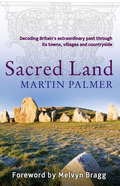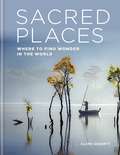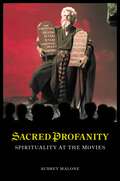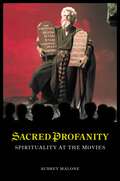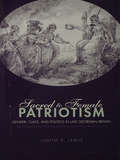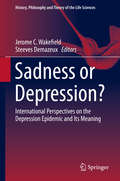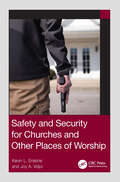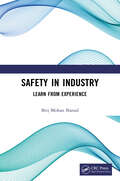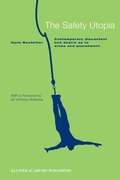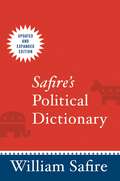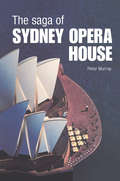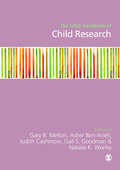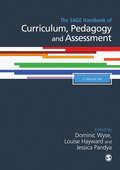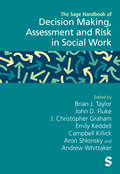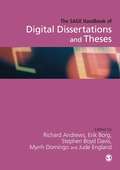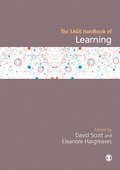- Table View
- List View
Sacred Land: Decoding Britain's extraordinary past through its towns, villages and countryside
by Martin PalmerSACRED LAND will enable you to discover the hidden secrets and meaning of the landscape around you, town or country, modern or old, wherever you live in Britain. There has been a dramatic growth in interest in our own history, buildings, landscape, sacred places, beliefs and culture over the last few years and this book will equip you with the tools to unlock the meaning, stories and history that are literally embedded in our landscape. It takes us from street names to churches; from hill forts to burial mounds; from the way a road bends to the shapes of fields in order to understand better the land that lies beneath our feet. In the literal shape of our countryside can be detected the eddies of time, politics, belief, warfare, passion and the durability of the human existence.SACRED LAND is a fascinating, accessible read and the perfect reference guide to have in your home or in your car. It will be of interest to everyone who loves history, sacred places and sacred history, and those who like to explore their ancestry and roots.
Sacred Places: Where to find wonder in the world
by Clare GogertyWellness travellers are seeking transformative experiences - wellness is, by nature, a journey and a quest. The concept of transformative travel is about finding experiences through trips that shift perspective and allow digital detoxing, connection with oneself, nature, communities and a sense of the bigger picture in life.Sacred Places is a stunning new coffee table exploration for seekers of unusual and enlightening destinations, for both armchair travelling and as inspiration for future journeys. The book will be particularly focused on experiences, in addition to a full description of the place. For example, plant medicine ceremonies in South America, walking the Camino Way, Stonehenge on the winter solstice, wild swimming in Iceland's sacred hot springs and silent retreats. Entries also introduce the history and geography of the place, significant stories, dates to visit, myths, legends and ceremonies.
Sacred Profanity: Spirituality at the Movies
by Aubrey MaloneThis book offers a history of films with Biblical, spiritual, and supernatural themes.This volume follows the evolution of one of the Hollywood's longest running thematic concerns. From the silent era to the present, Sacred Profanity: Spirituality at the Movies examines the rich diversity of films with spiritual themes—films that reflect our own fascination with the divine and supernatural, while evoking the specific times in which they were created.From Birth of a Nation to Angels and Demons, Sacred Profanity discusses over 180 films with an insightful, movie lover's approach. Coverage encompasses Biblical stories like King of Kings; films about spiritual characters, such as The Nun's Story; foreign masterpieces like The Seventh Seal; movies that incorporate spiritual symbolism, such as Taxi Driver and Cool Hand Luke; horrifying visions of the Satanic like The Exorcist, and controversial works like The Last Temptation of Christ. The book also looks at the history of Hollywood's attempt to maintain moral order through censorship, as well as the growing influence of filmmakers' own spiritual beliefs on the movies we see.
Sacred Profanity: Spirituality at the Movies
by Aubrey MaloneThis book offers a history of films with Biblical, spiritual, and supernatural themes.This volume follows the evolution of one of the Hollywood's longest running thematic concerns. From the silent era to the present, Sacred Profanity: Spirituality at the Movies examines the rich diversity of films with spiritual themes—films that reflect our own fascination with the divine and supernatural, while evoking the specific times in which they were created.From Birth of a Nation to Angels and Demons, Sacred Profanity discusses over 180 films with an insightful, movie lover's approach. Coverage encompasses Biblical stories like King of Kings; films about spiritual characters, such as The Nun's Story; foreign masterpieces like The Seventh Seal; movies that incorporate spiritual symbolism, such as Taxi Driver and Cool Hand Luke; horrifying visions of the Satanic like The Exorcist, and controversial works like The Last Temptation of Christ. The book also looks at the history of Hollywood's attempt to maintain moral order through censorship, as well as the growing influence of filmmakers' own spiritual beliefs on the movies we see.
Sacred to Female Patriotism: Gender, Class, and Politics in Late Georgian Britain
by Judith Lewis SMissing from much of the scholarship on 18th century British politics is recognition of the extensive participation of aristocratic women. Fortunately, as a literate and self-conscious group, these women created and preserved vast manuscript collections now available to historians. In Sacred to Female Patriotism, Judith S. Lewis taps into these sou
Sacred to Female Patriotism: Gender, Class, and Politics in Late Georgian Britain
by Judith Lewis SMissing from much of the scholarship on 18th century British politics is recognition of the extensive participation of aristocratic women. Fortunately, as a literate and self-conscious group, these women created and preserved vast manuscript collections now available to historians. In Sacred to Female Patriotism, Judith S. Lewis taps into these sou
Sadness or Depression?: International Perspectives on the Depression Epidemic and Its Meaning (History, Philosophy and Theory of the Life Sciences #15)
by Jerome C. Wakefield Steeves DemazeuxThe World Health Organization states that depression is the leading cause of disability worldwide, and predicts that by 2030 the epidemic of depression raging across the world will be the single biggest contributor to the overall burden of disease of all health conditions. Yet this gloomy picture masks a number of paradoxes concerning the diagnosis and cultural interpretation of depression that appear to challenge the claimed prevalence rates on which it is based. This book’s essays by some of the world’s leading researchers and scholars on depression explores these anomalies in detail from multidisciplinary and multicultural perspectives, and in doing so reshapes the debate on the nature of depression that is currently under way in the US and abroad. At the book’s core is the exploration from the multiple perspectives of a key dilemma: is the epidemic of depression real or is it just apparent? In particular, could it be the result of criteria laid down in the official American classification system of mental disorders, the DSM, interacting with cultural changes to reshape our view of melancholy, pathologizing what were formerly normal symptoms of grief or intense sadness? The debate over the DSM's conception of depression has an international relevance, with the WHO’s upcoming revisions to its International Classification of Diseases requiring coordination with the DSM. This collection of perspectives has an unprecedented international dimension, as scholars from Europe and around the world join US academics to explore a central and controversial element of contemporary psychiatric diagnosis - and one that has enormous practical implications for the future of mental health care and how we view our emotions. The book’s accessible essays will make it useful to scholars, practitioners, and students across a wide range of disciplines.
Safety and Security for Churches and Other Places of Worship
by Kevin L. Erskine Joy A. VolpiSafety and Security for Churches and Other Places of Worship is a reference book focused on how to form a first responder team for churches, synagogues, temples, and other places of worship. It will assist team leaders on how to train for both security and medical emergencies, provide training aids and ideas, and how to write SOPs and legal issues. Trending violence directed at soft targets is growing, forcing places of worship to respond with highly trained personnel to quickly intervene. Many medical incidents can have drastically better outcomes if trained medical personnel render immediate medical care. For instance, the use of an AED in conjunction with CPR can drastically improve survival rates from 15% to 85%, versus just CPR alone. Topics covered include: Environmental disasters Acts of violence Active shooter incidents Bomb threats Unruly/disruptive persons Suspect control Sexual abuse Realistic training using fake wounds Tabletop exercises Team building Medical emergencies An equipment chapter helps to determine what equipment is a priority for teams limited by budget. Some equipment can mean the difference between a "friend" being mistaken for an aggressor, resulting in an innocent person being injured or killed. Safety and Security for Churches and Other Places of Worship is a must-have reference for anyone charged with the duty to protect those who attend and work at places of worship.
Safety and Security for Churches and Other Places of Worship
by Kevin L. Erskine Joy A. VolpiSafety and Security for Churches and Other Places of Worship is a reference book focused on how to form a first responder team for churches, synagogues, temples, and other places of worship. It will assist team leaders on how to train for both security and medical emergencies, provide training aids and ideas, and how to write SOPs and legal issues. Trending violence directed at soft targets is growing, forcing places of worship to respond with highly trained personnel to quickly intervene. Many medical incidents can have drastically better outcomes if trained medical personnel render immediate medical care. For instance, the use of an AED in conjunction with CPR can drastically improve survival rates from 15% to 85%, versus just CPR alone. Topics covered include: Environmental disasters Acts of violence Active shooter incidents Bomb threats Unruly/disruptive persons Suspect control Sexual abuse Realistic training using fake wounds Tabletop exercises Team building Medical emergencies An equipment chapter helps to determine what equipment is a priority for teams limited by budget. Some equipment can mean the difference between a "friend" being mistaken for an aggressor, resulting in an innocent person being injured or killed. Safety and Security for Churches and Other Places of Worship is a must-have reference for anyone charged with the duty to protect those who attend and work at places of worship.
Safety in Industry: Learn from Experience
by Brij Mohan BansalThis concise book presents years of the author’s practical experiences on industrial safety through various case studies. It aims to quip professionals in their respective industrial fields with different safety management systems, like the knowledge of common dos and don’ts, Standard Operating Procedures (SOP), and even the Emergency handling and use of PPEs. Print edition not for sale in South Asia (Bangladesh, Bhutan, India, Nepal, Pakistan and Sri Lanka)
Safety in Industry: Learn from Experience
by Brij Mohan BansalThis concise book presents years of the author’s practical experiences on industrial safety through various case studies. It aims to quip professionals in their respective industrial fields with different safety management systems, like the knowledge of common dos and don’ts, Standard Operating Procedures (SOP), and even the Emergency handling and use of PPEs. Print edition not for sale in South Asia (Bangladesh, Bhutan, India, Nepal, Pakistan and Sri Lanka)
The Safety Utopia: Contemporary Discontent and Desire as to Crime and Punishment
by Hans BoutellierMy ?rst encounter with the world of crime and punishment was more than two decades ago, and it has since undergone vast changes. No one could have foreseen that crime-related problems would occupy such a prominent position in cultural awareness. Crime is on the rise, the public attention devoted to it has increased even more, and its political importance has mushroomed. The major change in the 1990s was perhaps the transformation of crime into a safety issue. Crime is no longer a matter involving offenders, victims, the police and the courts, it involves everyone and any number of agencies and institutions from security companies to the local authorities and from schools to pub and restaurant owners. Crime has become a much larger complex than the judicial system—a complex organized mentally and institutionally around this one concept of safety. In this book I make an effort to get to the bottom of this complex. It is the sequel to my dissertation Crime and Morality—The Moral Signi?cance of Criminal Justice in a Postmodern Culture (2000), where I hold that the victim became the essence of crime in Western culture, and that this in turn shaped public morality. In the second half of the twentieth century, a personal morality based on an awareness of our own and other people’s vulnerability, i. e. potential victimhood, succeeded the ethics of duty.
Safire's Political Dictionary
by William SafireWhen it comes to the vagaries of language in American politics, its uses and abuses, its absurdities and ever-shifting nuances, its power to confound, obscure, and occasionally to inspire, William Safire is the language maven we most readily turn to for clarity, guidance, and penetrating, sometimes lacerating, wit. Safire's Political Dictionary is a stem-to-stern updating and expansion of the Language of Politics, which was first published in 1968 and last revised in 1993, long before such terms as Hanging Chads, 9/11 and the War on Terror became part of our everyday vocabulary. Nearly every entry in that renowned work has been revised and updated and scores of completely new entries have been added to produce an indispensable guide to the political language being used and abused in America today. Safire's definitions--discursive, historically aware, and often anecdotal--bring a savvy perspective to our colorful political lingo. Indeed, a Safire definition often reads like a mini-essay in political history, and readers will come away not only with a fuller understanding of particular words but also a richer knowledge of how politics works, and fails to work, in America. From Axis of Evil, Blame Game, Bridge to Nowhere, Triangulation, and Compassionate Conservatism to Islamofascism, Netroots, Earmark, Wingnuts and Moonbats, Slam Dunk, Doughnut Hole, and many others, this language maven explains the origin of each term, how and by whom and for what purposes it has been used or twisted, as well as its perceived and real significance. For anyone who wants to cut through the verbal haze that surrounds so much of American political discourse, Safire's Political Dictionary offers a work of scholarship, wit, insiderhood and resolute bipartisanship.
The Saga of Sydney Opera House: The Dramatic Story of the Design and Construction of the Icon of Modern Australia
by Peter MurrayPeter Murray's compelling and highly readable biography of the building presents both sides of the story. Using previously unpublished files and papers, Murray has managed to unravel one of the most intriguing architectural controversies of recent times - what really happened when they built Sydney Opera House...
The Saga of Sydney Opera House: The Dramatic Story of the Design and Construction of the Icon of Modern Australia
by Peter MurrayPeter Murray's compelling and highly readable biography of the building presents both sides of the story. Using previously unpublished files and papers, Murray has managed to unravel one of the most intriguing architectural controversies of recent times - what really happened when they built Sydney Opera House...
The SAGE Handbook of Child Research
by Dr Gary B. Melton Gail S. Goodman Mr Asher Ben-Arieh Ms Judith Cashmore Ms Natalie K. Worley"It is refreshing to see a book such as this which is both broad in its conceptualization of the field of child research and deep in its focus. The volume's editors are paragons of awareness when it comes to the need for interdisciplinary research and theory to illuminate the lives and experience of children." - James Garbarino, Loyola University Chicago "Covers a satisfying and unprecedentedly wide range of research relating to childhood. The contributors include many eminent international scholars of childhood, making the book a valuable resource for child researchers. Child advocates will also find the book to be invaluable in their efforts to improve children’s well-being, and to change policies and practices for the better." - Anne Smith, University of Otago "A really scintillating collection that will provide a lasting perspective on child studies - stimulating and comprehensive!" - Jonathan Bradshaw, University of York In keeping with global changes in children's social and legal status, this Handbook includes examination of children as family members, friends, learners, consumers, people of faith, and participants in law and politics. The contributors also discuss the methodological and ethical requirements for research that occurs in natural settings and that enables children themselves to describe their perspective. The book is divided into three parts: Part I: Setting-Specific Issues in Child Research Part II: Population-Specific Issues in Child Research Part III: Methods in Research on Children and Childhood
The SAGE Handbook of Child Research (PDF)
by Dr Gary B. Melton Gail S. Goodman Mr Asher Ben-Arieh Ms Judith Cashmore Ms Natalie K. Worley"It is refreshing to see a book such as this which is both broad in its conceptualization of the field of child research and deep in its focus. The volume's editors are paragons of awareness when it comes to the need for interdisciplinary research and theory to illuminate the lives and experience of children." - James Garbarino, Loyola University Chicago "Covers a satisfying and unprecedentedly wide range of research relating to childhood. The contributors include many eminent international scholars of childhood, making the book a valuable resource for child researchers. Child advocates will also find the book to be invaluable in their efforts to improve children’s well-being, and to change policies and practices for the better." - Anne Smith, University of Otago "A really scintillating collection that will provide a lasting perspective on child studies - stimulating and comprehensive!" - Jonathan Bradshaw, University of York In keeping with global changes in children's social and legal status, this Handbook includes examination of children as family members, friends, learners, consumers, people of faith, and participants in law and politics. The contributors also discuss the methodological and ethical requirements for research that occurs in natural settings and that enables children themselves to describe their perspective. The book is divided into three parts: Part I: Setting-Specific Issues in Child Research Part II: Population-Specific Issues in Child Research Part III: Methods in Research on Children and Childhood
The SAGE Handbook of Curriculum, Pedagogy and Assessment
by Ms Jessica Pandya Professor Dominic Wyse Ms Louise HaywardThe research and debates surrounding curriculum, pedagogy and assessment are ever-growing and are of constant importance around the globe. With two volumes - containing chapters from highly respected researchers, whose work has been critical to understanding and building expertise in the field – The SAGE Handbook of Curriculum, Pedagogy and Assessment focuses on examining how curriculum is treated and developed, and its impact on pedagogy and assessment worldwide. The Handbook is organised into five thematic sections, considering: · The epistemology and methodology of curriculum · Curriculum and pedagogy · Curriculum subjects · Areas of the curriculum · Assessment and the curriculum · The curriculum and educational policy The SAGE Handbook of Curriculum, Pedagogy and Assessment’s breadth and rigour will make it essential reading for researchers and postgraduate students around the world.
The SAGE Handbook of Curriculum, Pedagogy and Assessment
by Ms Jessica Pandya Professor Dominic Wyse Ms Louise HaywardThe research and debates surrounding curriculum, pedagogy and assessment are ever-growing and are of constant importance around the globe. With two volumes - containing chapters from highly respected researchers, whose work has been critical to understanding and building expertise in the field – The SAGE Handbook of Curriculum, Pedagogy and Assessment focuses on examining how curriculum is treated and developed, and its impact on pedagogy and assessment worldwide. The Handbook is organised into five thematic sections, considering: · The epistemology and methodology of curriculum · Curriculum and pedagogy · Curriculum subjects · Areas of the curriculum · Assessment and the curriculum · The curriculum and educational policy The SAGE Handbook of Curriculum, Pedagogy and Assessment’s breadth and rigour will make it essential reading for researchers and postgraduate students around the world.
The Sage Handbook of Decision Making, Assessment and Risk in Social Work
by Brian J. Taylor John D. Fluke J. Christopher Graham Emily Keddell Campbell Killick Aron Shlonsky Andrew WhittakerThe SAGE Handbook on Decision Making, Assessment and Risk in Social Work provides a comprehensive overview of key strands of research and theoretical concepts in this increasingly important field. With 49 chapters and four section summaries, this Handbook describes the ‘state of the art’; discuss key debates and issues; and gives pointers on future directions for practice, research, teaching, management of services, and development of theoretical understandings. A key aim of this Handbook is to support the development of sound, applied knowledge and values to underpin reasoned professional judgement and decision making by social workers in practice and those in management and regulatory roles. With contributions from a global interdisciplinary body of leading and emerging scholars from a wide variety of roles, this handbook has been designed to be internationally generalisable and applicable to all major areas of social work. This Handbook provides a field-defining account of decision making, assessment and risk in social work which is unrivalled for its diversity and strength of coverage, and will be of value to social work researchers, teachers and practitioners, as well as to those in allied fields such as health care. Section 1: Professional Judgement Section 2: Assessment, Risk and Decision Processes Section 3: Assessment Tools and Approaches Section 4: Developing and Managing Practice Section 5: Concluding Section / Afterword
The Sage Handbook of Decision Making, Assessment and Risk in Social Work
by Brian J. Taylor John D. Fluke J. Christopher Graham Emily Keddell Campbell Killick Aron Shlonsky Andrew WhittakerThe SAGE Handbook on Decision Making, Assessment and Risk in Social Work provides a comprehensive overview of key strands of research and theoretical concepts in this increasingly important field. With 49 chapters and four section summaries, this Handbook describes the ‘state of the art’; discuss key debates and issues; and gives pointers on future directions for practice, research, teaching, management of services, and development of theoretical understandings. A key aim of this Handbook is to support the development of sound, applied knowledge and values to underpin reasoned professional judgement and decision making by social workers in practice and those in management and regulatory roles. With contributions from a global interdisciplinary body of leading and emerging scholars from a wide variety of roles, this handbook has been designed to be internationally generalisable and applicable to all major areas of social work. This Handbook provides a field-defining account of decision making, assessment and risk in social work which is unrivalled for its diversity and strength of coverage, and will be of value to social work researchers, teachers and practitioners, as well as to those in allied fields such as health care. Section 1: Professional Judgement Section 2: Assessment, Risk and Decision Processes Section 3: Assessment Tools and Approaches Section 4: Developing and Managing Practice Section 5: Concluding Section / Afterword
The Sage Handbook of Decision Making, Assessment and Risk in Social Work
The SAGE Handbook on Decision Making, Assessment and Risk in Social Work provides a comprehensive overview of key strands of research and theoretical concepts in this increasingly important field. With 49 chapters and four section summaries, this Handbook describes the ‘state of the art’; discuss key debates and issues; and gives pointers on future directions for practice, research, teaching, management of services, and development of theoretical understandings. A key aim of this Handbook is to support the development of sound, applied knowledge and values to underpin reasoned professional judgement and decision making by social workers in practice and those in management and regulatory roles. With contributions from a global interdisciplinary body of leading and emerging scholars from a wide variety of roles, this handbook has been designed to be internationally generalisable and applicable to all major areas of social work. This Handbook provides a field-defining account of decision making, assessment and risk in social work which is unrivalled for its diversity and strength of coverage, and will be of value to social work researchers, teachers and practitioners, as well as to those in allied fields such as health care. Section 1: Professional Judgement Section 2: Assessment, Risk and Decision Processes Section 3: Assessment Tools and Approaches Section 4: Developing and Managing Practice Section 5: Concluding Section / Afterword
The SAGE Handbook of Digital Dissertations and Theses: SAGE Publications (PDF)
by Erik Borg Jude England Myrrh Domingo Stephen N. Davis Mr Richard N. L. AndrewsThis handbook sets out the processes and products of 'digital' research. It is a theoretical and practical guide on how to undertake and navigate advanced research in the arts, humanities and social sciences. Topics covered include: - how to make research more accessible - the use of search engines and other sources to determine the scope of work - research training for students - what will theses, dissertations and research reports look like in ten years' time? - the storing and archiving of such research - ethics and methodologies in the field - intercultural issues The editors focus on advances in arts and practice-based doctorates, and their application in other fields and disciplines. The contributions chart new territory for universities, research project directors, supervisors and research students regarding the nature and format of Masters and doctoral work, as well as research projects. This handbook is an essential reference for researchers, supervisors and administrators on how to conduct and evaluate research projects in a digital and multimodal age. Richard Andrews is Professor in English, Faculty of Children and Learning, Institute of Education. Erik Borg is a Senior Lecturer at Coventry University's Centre for Academic Writing. Stephen Boyd Davis is Research Leader in the School of Design, Royal College of Art. Myrrh Domingo is Visiting Assistant Professor in English Education and Literacy Education at New York University. Jude England is Head of Social Sciences at the British Library.
The SAGE Handbook of Digital Dissertations and Theses: SAGE Publications
by Erik Borg Jude England Myrrh Domingo Stephen N. Davis Mr Richard N. L. AndrewsThis handbook sets out the processes and products of 'digital' research. It is a theoretical and practical guide on how to undertake and navigate advanced research in the arts, humanities and social sciences. Topics covered include: - how to make research more accessible - the use of search engines and other sources to determine the scope of work - research training for students - what will theses, dissertations and research reports look like in ten years' time? - the storing and archiving of such research - ethics and methodologies in the field - intercultural issues The editors focus on advances in arts and practice-based doctorates, and their application in other fields and disciplines. The contributions chart new territory for universities, research project directors, supervisors and research students regarding the nature and format of Masters and doctoral work, as well as research projects. This handbook is an essential reference for researchers, supervisors and administrators on how to conduct and evaluate research projects in a digital and multimodal age. Richard Andrews is Professor in English, Faculty of Children and Learning, Institute of Education. Erik Borg is a Senior Lecturer at Coventry University's Centre for Academic Writing. Stephen Boyd Davis is Research Leader in the School of Design, Royal College of Art. Myrrh Domingo is Visiting Assistant Professor in English Education and Literacy Education at New York University. Jude England is Head of Social Sciences at the British Library.
The SAGE Handbook of Learning
by Dr Eleanore Hargreaves Professor David Scott"Profound and useful, readers will benefit from the systematic treatment of learning through superb scholarship. Cultural-philosophical-curricular-pedagogical-historical perspectives on learning, curriculum, pedagogy, and assessment, and learners make this collection unique." - Carol A. Mullen, Professor of Educational Leadership, Virginia Tech Learning is a fundamental topic in education. Combining traditional views of learning and learning theory with sociocultural and historical perspectives, this Handbook brings together original contributions from respected researchers who are leading figures in the field. The editors provide a insightful introduction to the topic, and the theories, frameworks, themes and issues discussed in the individual chapters are central to each and every learning episode. The Handbook is organized into four sections, each beginning with a short introduction: Philosophical, Sociological and Psychological Theories of Learning Models of Learning Learning, Curriculum, Pedagogy and Assessment Learning Dispositions, Life-Long Learning and Learning Environments
